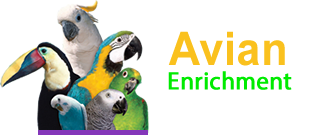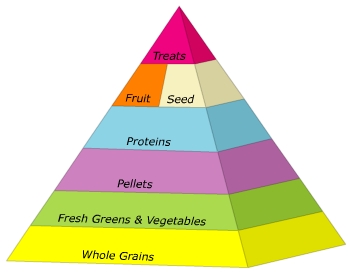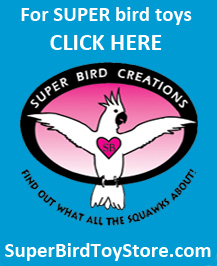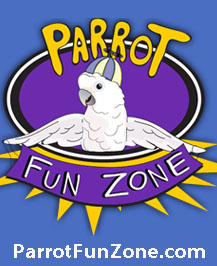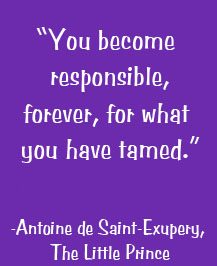- Category: Diet & Nutrition
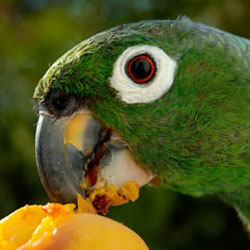
When it comes to caring for our pet birds, nothing seems to be more controversial than the topic of diet and nutrition. However, nothing is as important as making sure your bird has a healthy and complete diet. It has been estimated that up to 75% of bird illnesses are avoidable by providing a nutritional, well balanced diet.
Many opinions flourish on what to feed and in what proportions. Before we delve into the issues, let's take a look at what a typical diet may consist of for our pet's wild counterparts.
In nature, parrots spend the majority of their day foraging for food and, in doing so, expend vast amounts of energy locating and flying to the best feeding sources, climbing around trees to reach the choicest tidbits and using their beaks to open pods and nut shells. It is typical for birds to search for food in the morning and again in the late afternoon. Feeding your bird fresh foods twice a day and also leaving dried foods available throughout the day would most closely mimic and support the natural feeding cycle. complete diet. It has been estimated that up to 75% of bird illnesses are avoidable by providing a nutritional, well balanced diet.
Many opinions flourish on what to feed and in what proportions. Before we delve into the issues, let's take a look at what a typical diet may consist of for our pet's wild counterparts.
Wild parrots are opportunistic feeders and consume a multitude of items based on seasonal availability. Parrots eat raw foods such as fruits and vegetable matter, nuts, grains, seeds, sprouts, berries, flowers, pollen, insects and larvae. Many species also supplement their diets by eating clay and salt licks.
For domestic parrots, many of the food challenges and choices have been taken away from them. Each day they are presented with a bowl of food with no need to expend and therefore consume lots of calories. In a domestic environment, it is entirely the responsibility of the parrot's human companion to provide a diet that meets the daily nutritional requirements for their bird.
Although commercial diets have significantly improved, no one commercial diet comes close to simulating how they eat in nature and none of the commercial diets provide for 100% of the nutritional needs of our birds. To date, there just hasn't been enough research. Given the complexity of the task at hand, no immediate single solution breakthroughs are expected.
Since commercial diets can't reliably replicate a bird's natural diet, it appears that offering a broad range of nutrition and a wide variety of healthy food choices is the key to maintaining a healthy bird.
Giving your bird a varied selection of foods will not only keep them healthy and beautiful but, it will also make their lives much more interesting. Imagine how dull our existence would be if we had to eat the same meal over and over again for the rest of our days! Your birds will relish the opportunity to make choices and try new foods and they will delight in exploring different tastes and textures. Additionally, presenting the food in interesting ways to trigger natural foraging behaviors will also stimulate your bird both physically and mentally.
The specific nutritional requirements for each species will differ but, in general, all parrots require a varied, well rounded diet that includes a daily combination of fresh greens, vegetables, grains, legumes, fruit, and pellets. This can be supplemented with a sprinkling of seeds and occasional treats but, in general, these should be just a small portion of what parrots eat each day (<10%).
Other factors that can impact your bird's dietary needs include:
- breeding status
- health status
- level of exercise
- age
- molting
The following diagram illustrates the relative proportions of grains, vegetables, fruits, pellets, seeds and treats that should be the basis of a bird's diet. Bird owners are strongly encouraged to research in more detail the specific needs for each of the parrot species in their flock to ensure the balance is fine tuned and other Species Specific Dietary Needs are addressed (i.e., low fat for Amazons, higher fat content for Macaws, increased vitamin A for Eclectus, low iron for softbills, lory diets).
Click on the diagram above to learn more about each food group category
For specific information on the benefits and sources of specific nutrients please refer to our article: Nutrients: Sources and Benefits.
Write comment (0 Comments)- Category: Diet & Nutrition
The following diagram illustrates the relative proportions of grains, vegetables, fruits, pellets, seeds and treats that should be the basis of a bird's diet.
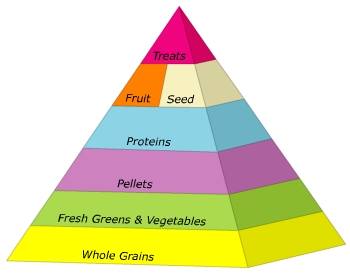
Whole Grains (25 - 40%)
Whole grains contain all elements of the kernel: bran, germ and endosperm. The bran and germ contain a variety of health-enhancing components including dietary fiber, phytochemicals, vitamins, trace minerals and small amounts of unsaturated fat.

(Source: www.ag.ndsu.edu Whole Grains: Agriculture to Health, Jane U. Edwards, Ph. D.)
Refined grains primarily contain the ground endosperm of the kernel, with both the bran and germ removed. Loss of the bran and germ reduces the fiber content (especially insoluble fiber) and a number of health-enhancing components. Refined grains are “enriched” with a limited number of nutrients - vitamins (thiamin, riboflavin, niacin) and minerals (iron) - added back. Refined grains also are “fortified” with folic acid at more than twice the level found in whole grains.
Here are some examples of whole grain foods:
| Amaranth | Millet | Unsweetened cereals |
| Barley | Oat groats | Whole grain pasta |
| Brown rice | Oat bran | Whole grain breads |
| Buckwheat (kasha) | Quinoa | Low fat granola |
| Bulgur | Wild rice | Oatmeal |
| Cous cous | Wheat berries | Rye Berries |
| Corn | Wheat germ | Kamut |
Fresh Greens & Veggies (25 - 40%)
Leafy green and dark yellow-orange vegetables are a bountiful source of nutrients and, as a rule, the darker the color the more nutritious. Dark leafy vegetables contain: Vitamins A, B6, B12, C, D, E, also calcium, potassium, magnesium, and iron. Vegetables contain nutrients that are important for vision, hearing, skin, bones, mucus membranes, as well as assisting in the growth and repair of tissues. Vegetables are best when fresh but thawed frozen vegetables are acceptable when fresh options are not available.
Vegetables with the most nutrients include:
| Collard greens | Green beans | Carrots |
| Mustard greens | Peas | Squash |
| Turnip greens | Pumpkin | Endive |
| Brussels Sprouts | Dandelion | Hot Peppers |
| Bok Choy | Sweet potato | Broccoli |
| Turnips | Yams | Parsley |
| Corn | Spinach |
Organic produce should be provided to your bird if at all possible to minimize their exposure to toxic contaminants.
Pellets (15 - 25%)
Manufactured pellets and extruded diets have been formulated to include a balanced selection of vitamins, minerals, carbohydrates and proteins.
Protein (10-15%)
Proteins are made up of amino acids which are commonly referred to as the building blocks of life. Proteins are crucial to muscle growth and maintenance as well as critical to the health of feathers, beaks and organs. Legumes are a great source of protein, carbohydrates, and they are low in fats. Dairy products can be used as a source of protein in limited amounts. Beans, in combination with brown rice, create a complete protein that is assimilated more fully than animal proteins. Proteins are found in:
| Eggs (fully cooked) | Navy beans | Brown rice/bean mix |
| Tofu | Chicken (fully cooked) | Pinto beans |
| Kidney beans | Lentils | Mung beans |
| Garbanzo beans | Peanuts | Tuna |
| Low fat yogurt | Low Fat Cheese |
Fruits (5 - 15%)
Fruits contain carbohydrates, vitamin C, potassium, folic acid and most are filled with fiber. Fruits are generally high in sugar content and are not as nutritious as veggies. Fruits with the highest level of phytonutrients are:
| Apple* | Grapes | Peaches* |
| Apricots* | Kiwi | Pineapple |
| Banana | Mango | Pomegranate |
| Blackberries | Nectarines | Raspberries |
| Blueberries | Oranges | Strawberries** |
| Papaya | Cantaloupe | Sour cherries* |
* should be pitted and seeded
** wild or organic only
Organic produce should be provided to your bird, if at all possible, to minimize their exposure to toxic contaminants. Berries should be organically grown as they can harbor bacteria and insecticides and they are extremely difficult to clean completely.
Seeds (<10%)
Seeds embody many nutrients such as: protein; vitamins A, B, D, and E; as well as lipids and fatty acids. Without lipids in the diet a parrot cannot absorb the fat soluble vitamins (A,D,E and K). Fatty acids are broken into two categories: essential and non-essential. Non-essential fatty acids can be manufactured by a healthy parrot's body if they are provided the proper balance of vitamins and minerals. Essential fatty acids (EFA) are nutrients that the body cannot manufacture and therefore must be supplemented from dietary sources. The two most significant EFA's are Omega 3 and Omega 6.
Sources of Omega 3: Flax seed, Hemp seed
Sources of Omega 6: Hemp seed, sunflower seed, safflower seed, Pumpkin seed, nuts
Seeds come in many different sizes, shapes, colors and texture. Parrots enjoy opening, cracking, and shredding the hulls of seeds to get at the tasty centers. This helps to fulfill your parrot’s psychological need to forage for its food.
Treats (<5%)
Nuts contain proteins, minerals, vitamins and healthy fats which are a good source of energy. Domestic parrots do not have the same activity level as wild parrots and therefore, they do not need to consume as many nuts as their wild counterparts. Nuts should be given only as treats to prevent obesity. Nuts include:
| Almonds | Macadamia Nuts | Pine Nuts |
| Brazil Nuts | Palm Nuts | Walnuts |
| Hazelnuts | Pecans |
Water
Although water is not a "food group" or even officially a nutrient, it is vitally important to your bird's health and ability to function at the cellular level. Water performs many functions in the body. It is water that regulates the important function of body temperature. Water also carries nutrients, hormones and enzymes throughout the body and transports waste away from the cells. Since the body is made up of mostly water, it is imperative that your parrot have continual access to water for proper bodily functions.
Domestic birds obtain water from three sources:
- The fresh water you provide daily in it's cage.
- Water is obtained from fresh vegetables and fruits. Parrots can also receive small amount of water from grains.
- Water is obtained through the body metabolizing fats, carbohydrates and proteins into energy.
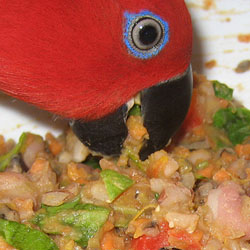 You want me to eat WHAT?
You want me to eat WHAT?
Changing your bird from an all seed diet can be challenging and require a lot of patience but, ultimately, it is worth the effort. Birds are creatures of habit and can be suspicious of new foods. Unfortunately, change doesn't occur overnight for most birds. Your bird may totally ignore pellets and new fruits or veggies for several days because he doesn't recognize them as food.
Before attempting to convert your bird's diet, it is wise to consult with your avian vet to make sure your bird is healthy as well as to establish a baseline weight.
There have been various methods of conversion reported to be successful. A few of the basic concepts are:
- Take it slow. Start by offering the pellets in a separate dish. Maybe your bird will make the adjustment right away and dive right into the pellets. If not, mix the new formulated food with the seed mix and over a period of weeks gradually increase the ratio of pellets to seeds.
- Make a mixture of various formulated diets and observe which ones your bird prefers. Try different shapes, colors, sizes and textures of pellets.
- If your bird usually enjoys eating what you eat then pretend to eat the pellets to see if this stimulates his interest.
- Pretend to feed the new item to another human as a treat in front of your bird.
- Try feeding your bird the new items in a location outside of their cage such as at meal time with the family or on a playpen. Sometimes feeding in a new location will open them up to exploring new food items.
- Place pellets in foraging devices or offer them as treats during training sessions. Your parrot may get so caught up in the fun they might just decide to give them a try.
Things to watch out for....
When changing your bird's diet it is imperative to look for signs that your parrot is eating and not starving. Sometimes birds can fool you by just pulverizing the pellets rather than actually eating them.
- Monitor your bird's weight either with a scale or by carefully feeling around his keel bone on his chest to ensure he is maintaining a healthy weight.
- Monitor his food intake and make sure he is eating rather than just tossing and crushing the pellets.
- Physical cues that your bird may not be eating can include: inactivity, puffed feathers and loose or insufficient droppings.
If you suspect your bird has stopped eating consult with your avian vet for advice.
Write comment (0 Comments)- Written by: Pamela Clark
- Category: Diet & Nutrition
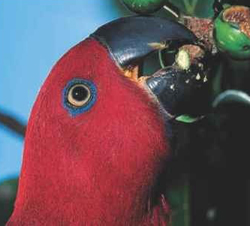 One of the greatest challenges facing parrot caregivers today is that of deciding upon and then committing to a healthy diet for our birds. It seems that every "authority" has a different opinion and no one can agree. Everyone, from behavior consultants to veterinarians, seems to have a different idea about what is correct.
One of the greatest challenges facing parrot caregivers today is that of deciding upon and then committing to a healthy diet for our birds. It seems that every "authority" has a different opinion and no one can agree. Everyone, from behavior consultants to veterinarians, seems to have a different idea about what is correct.
Most veterinarians agree that it is best to feed a 100% formulated (pelleted) diet with perhaps a small amount of added vegetables and fruits. They have good reasons for their convictions. First, the best of these diets will provide a parrot with excellent health. As a licensed veterinary technician, I have seen many happy parrots (who eat a 100% pelleted diet) in excellent plumage sail through their annual exams and lab work. Secondly however, without a good, solid knowledge of both the basics of nutrition and the pitfalls inherent in feeding parrots, it is almost impossible to devise a balanced diet and then get the parrot to eat it. Veterinarians know that most owners will fail at this, unless they provide knowledgeable, on-going guidance.
Nevertheless, I don't see a lot of parrot owners sticking to a 100% pelleted diet for their birds, despite the good reasons for doing so. First, it goes against our grain to feed such a boring diet to these vibrant, dynamic creatures, whose not-so-very-distant ancestors were picking and choosing for themselves from the native wild resources.
Beyond that, however, converting a parrot to a 100% pelleted diet can try the intestinal fortitude of even the least empathic of parrot owners. It can be painfully difficult to convert a parrot to eating a pelleted diet, if he has been enjoying higher fat foods, because it usually requires that we create enough hunger that they are forced to try this new diet.
It is still the norm that young parrots sent home from pet stores and breeders are eating seed mixes as dietary staples. And, the majority of older parrots relinquished to rescue and adoption organizations are usually on seed diets as well. In my experience, unless a method is used that creates hunger in the parrot, it is extremely difficult to transition a parrot from eating a seed mix to a pelleted diet, if these are the only two choices offered.
Usually, people just mix the two together, the parrot keeps happily eating the seed, and the owner is able to feel somewhat content in the fact that at least he has offered the pellets. Fundamentally, however, this is a little like offering a two-year-old child a choice between potato chips and broccoli. You can see the problem.
So, we caregivers are part of the problem. Quite understandably, we want to offer a diet to our parrot that includes a variety of interesting ingredients. We also are social eaters – it's fun to share our meals with our parrots. Further, as humans, we have a tendency to structure our own meals around our appetites.
And, here is the crux of the problem, when it comes to the way we feed our own parrots: we seek to discover our parrots' own appetites to see what they like best. This practice leads to one of the greatest pitfalls we experience as parrot caregivers.
As humans, our own appetites have evolved as a result of childhood experiences, parental teachings, emotions, ethical values, and a host of other social criteria that we bring to bear upon our food choices. Parrots, on the other hand, developed their appetites in the wild. As we all know, most of the medium to large parrots we call family members are only a few generations out of the wild. They still have all the same instincts as their wild counterparts.
I have watched parrots make food choices for over 30 years now, and it is true that they show a preference for foods that are high in carbohydrates and fats. To my knowledge, there are no scientific studies that would support this hypothesis. However, I believe strongly that they are instinctively programmed to load up on these foods when they find them.
Both carbohydrates and fats are categories of nutrients that are used for energy production. In the wild, they are usually in relatively short supply. And, wild parrots have many ways in which they expend energy. So, it makes sense that parrots in the wild would seek out these foods, especially during times of the year when energy expenditure is at its greatest, such as during breeding season.
The problem is obvious, then. They bring these same instincts with them into captivity, where unfortunately, these categories of nutrients exist in our own diets in abundant supply, but where energy expenditure for parrots is greatly reduced.
In my experience, in any parrot/human relationship, either the parrot is teaching the human, or the human is teaching the parrot. Parrots in captivity around the world are doing an exceptionally great job of teaching humans to feed them carbohydrates and fats as dietary staples.
When, in the process of doing a consultation, I ask an owner for a list of the parrot's favorite foods, I often get a list that reads like the Super Bowl Family Buffet Table: chicken wings, Fruit Loops cereal, granola, dried fruit, nuts, pasta, peanut better crackers, peanut butter pretzels, yogurt dips, mashed potatoes, white rice, dried Chinese noodles, chips, and crackers. These are the snack foods that have been added onto the dietary staple of seed mix.
As mentioned earlier, often in an attempt to improve the diet, the caregiver has mixed pellets in with the seed mix. However, when asked if the parrot eats the pellets, the answer is usually, "No." These same well-meaning owners do also offer fresh fruit daily as well. Fresh fruit does contain valuable nutrients (fiber, pectin and enzymes), but fruit is still a carbohydrate.
A diet such as this will create for you, as the parrot caregiver, two main problems. First, it causes malnutrition in your beloved companion. A diet such as this, with seed and pellets mixed in and complimented by table food and fruit, will cause deficiencies in vitamin A, protein and calcium. It is also so high in fat that it will put the parrot at risk for obesity and fatty liver disease. Eating such a diet will inevitably lead to disease.
Of greater immediate inconvenience, however, is that it will cause an increase in the production of reproductive hormones, resulting is what is commonly referred to as "hormonal behavior." This behavior increases at this time of year and can lead us to distraction. Examples: parrots climb down from their cages and chew up the baseboards, linoleum, or even more inconvenient – those satellite television cables tacked along the baseboards. They want to bury themselves in the couch cushions, which is very cute, until you realize that you now need to somehow patch that hole with duct tape in a manner that won't be immediately evident to visitors. They become more territorial, suddenly attaching themselves to that visitor's neck in a surprisingly swift and acrobatic maneuver. And, they are LOUDER.
Carbohydrates and fats are categories of nutrients used for energy. Nesting takes up large amounts of energy. When a parrot eats a diet high in these nutrients, he's got the biological green light for locating that nest and luring someone inside, which results in no end of strange behavior, since our homes aren't exactly set up for this enterprise. Nor do we want them to be.
The goal: calm parrots who go through this period of the year in a sane fashion, happy to chew up their own toys and who maintain reasonable noise levels. The answer: feed them appropriately. This requires, however, that you decide that you will be teaching the parrot, rather than the other way around.
This article is not meant to be a complete overview of psittacine nutrition, complete with "how-tos." This information has already been produced and is available in several locations. However, I can give you some general guidelines to get you started so that you can begin to change the diet in a positive way, and in a manner that does not cause hunger for the parrot.
First, if you are feeding a seed mix, measure this so that you know how much you are offering each day. Do not fill the cup up and then replenish it when it is empty. Instead, offer fresh seed mix each day in a bowl by itself. Do not mix seed with pellets. The goal, at the end of your conversion process, will be that seeds are offered as treats only, or to create a foraging experience. However, we don't want to take away an important dietary staple at this point. So, for now, offer a measured amount that the parrot eats in one day. Feed that amount for two to three weeks, and then begin to reduce this gradually by about 10% each week. For those of you who don't think in terms of percentages, do this: take a teaspoon and measure out 10 teaspoons of seed into the dish. Feed that for two to three weeks. Then, for the next two weeks, feed only 9 teaspoons of seed each day. After two more weeks, decrease that to 8 teaspoons of seed a week. Continue with this process, as you introduce other foods. Along the way, your parrot will begin to eat the healthier foods you offer, so will not go hungry as the seed is decreased.
There are many excellent pellet formulations on the market but my preference is for undyed, organic formulations. I personally feed my own parrots the Harrison's High Potency pellets. As you have already discovered, parrots are usually suspicious of new things, so if you decide to switch your pellets don't make the change to these new pellets immediately. Instead, I want you to mix the new pellets into the old pellets. In the beginning, strive for about ¼ old pellets to ¾ new pellets. After a couple of weeks, make this mixture 50:50. Once your parrot begins to eat the new pellet brand, then you can gradually phase out the older one. Make sure that you offer these pellets in a separate dish. Do not mix them with anything else. And, as with the seed mix, replace these with fresh pellets each day.
Once you have converted your bird to pellets, you can think about offering more variety. The DVD, Feeding Our Parrots Well, which Kris Porter and I produced, makes this very easy. However, there are other ways to accomplish this, as well. The Lafeber Nutriberries and Avicakes are also formulated foods which many parrots enjoy. These can be served as an adjunct to the pelleted diet.
Parrots benefit from receiving live, raw fresh foods. Live, raw vegetables and fruits contain categories of nutrients that processed foods do not, such as enzymes, phytonutrients, and essential fatty acids. I think a reasonable goal is to provide two to three fruits and 5 to 7 vegetables each day. These can be cut up and placed into a third food bowl, or can be placed onto a food skewer. Do not be discouraged if your parrot doesn't touch these offerings. Just keep doing the right thing from long enough and he will eventually try them and learn to enjoy them.
There are also some soak and cooked bird diets which can be prepared and served for the evening meal. My advice would just be to stay away from any that contain pasta made from white flour. As our enthusiasm has grown for feeding our parrots a variety of healthful foods, different recipe books have become available as well. One of my favorites is Nourish to Flourish by Ann Brooks (www.phoenixlanding.org).
So, what about those treats you are so fond of feeding? My best advice – keep them out of the diet, except for when you want to use them to reinforce (reward) desirable behavior. For example, if you have a parrot who doesn't always go into his cage willingly, that's the time to reward him with one of those beloved peanut butter crackers (perhaps a half of one). If you have a parrot who doesn't always step up when you ask him to, then offer him a sunflower seed for doing so (once you've managed to get that seed mix out of the diet.)
I realize that it's hard to change your parrot's diet. I also realize you're afraid that he'll be angry if he doesn't get that beloved dry mix in the morning, full of all those Chinese noodles, Fruit Loops, dried fruit, nuts and seeds. Just remember, while adjustments aren't always comfortable, he will adjust and he'll be around a lot longer to love you well. Your job is to create a landscape of healthy food choices, stick to that and teach him to enjoy them. You can do it!
*************
Pamela Clark, CVT is a parrot behavior consultant. She provides assistance to owners of companion parrots both in the home and by telephone. Her particular areas of interest include the resolution of all behavior problems, but especially that of feather destructive behavior, excellent nutrition for each species and positive reinforcement training. Pamela frequently works with clients to re-pattern their parrots to a healthier diet. She is a well-known speaker and her articles have appeared in the Grey Play Round Table, the Companion Parrot Quarterly, Bird Talk Magazine, Birds USA, the Holistic Bird Newsletter, Parrots Magazine and Good Bird Magazine. She can be contacted for private consultations at (503) 606-0235 or at
Pamela Clark and Kris Porter have also just released a great DVD "Feeding Our Parrots Well" which can be purchased directly from Kris Porter's Parrot Enrichment website at www.parrotenrichment.com
Write comment (0 Comments)- Category: Diet & Nutrition
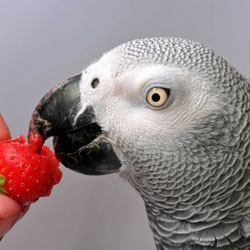 OK, so we've made the resolution to feed our feathered friends a well rounded, nutritional diet. What else do we have to worry about?
OK, so we've made the resolution to feed our feathered friends a well rounded, nutritional diet. What else do we have to worry about?
Toxins are Lurking!
- Fresh fruits and vegetables need to be washed to remove bacteria as well as pesticide and fungicide residues before feeding them to your parrot.
- All food must be checked for mold and fungal growth and discarded as necessary. Mold and fungi can be toxic to your bird!
- Food should be stored in appropriate containers at the appropriate temperature.
- Fresh foods should be removed from your bird's cage after no longer than 2 hours due to the potential for spoilage and bacterial growth.
- Use separate bowls for dry vs. wet foods.
- Keeping food and water dishes away from each other will assist in discouraging your parrot from dipping its food into the water dish.
- Dishes must be sanitized daily by scrubbing them out with hot, soapy water. This should be supplemented by a disinfecting soak in dilute bleach (1:32) or other bird safe disinfectant for several minutes at least 2-3 times a week.
- Fresh water must be available at all times. Birds require fresh water at least once a day and sometimes several times a day in a clean dish.
- If your bird loves to dunk and soak his food, consider using a water bottle to avoid bacterial contamination. (when converting to a water bottle make sure your bird is drinking from it). Note: Bacterial counts double every two hours!
- If you are serving hot foods, make sure that they are sufficiently cooled to avoid crop burn.
Poisonous/Dangerous Foods
Just as there are foods we should avoid as humans, there are foods that are potentially toxic or dangerous to your birds.
- Avocado
- Chocolate
- Carbonated beverages
- Alcohol
- Caffeinated beverages
- Seeds and pits from fruits (apple seeds contain cyanide)
- mushrooms (many species are potentially toxic)
- onions (can destroy red blood cells)
- commercially grown strawberries (extremely high pesticide residues)
- tomato leaves
- uncooked beans
- uncooked eggs
In general, other foods that should be avoided include:
- salty foods
- refined sugars
- fatty foods
- dairy products (not easily digested)
Please note that the above is not a complete list of potentially toxic items. If in doubt, consult with your avian veterinarian.
Write comment (0 Comments)- Category: Diet & Nutrition
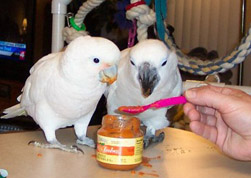 Polly Want a Cracker?
Polly Want a Cracker?
If the cracker is whole grain and low in sodium, go ahead and give it to your bird to enjoy! The general rule of thumb is that snacks that are healthy for you are healthy for your bird. As an added benefit, sharing your snack with your parrot will help to strengthen the bond between you.
Some handy and healthy snacks can include:
- Chicken bones with some meat still attached
- Potatoes
- Cooked whole grain pasta
- Whole wheat toast with a smear of jam
- A Piece of granola bar
- Human baby food served warm
- Unsweetened Applesauce
- Rice Cakes
- Unsalted nuts
A great selection of healthy parrot treats are now commercially available that have been designed with the health and enjoyment of your bird in mind such as:
- Birdie Breads
- Biscuits and Cakes
- Dried Fruits (unsulfured, no sugar added)
- Dried Veggies
- Mixed Treats
- Nutri-berries
- Nuts
- Parrot Popcorn
- Treat Sticks
A great way to provide your bird with it's favorite treats is to hide them in foraging devices. This will encourage this instinctual behavior and stimulate them both physically and mentally.
Write comment (0 Comments)- Written by: Carolyn Swicegood
- Category: Diet & Nutrition
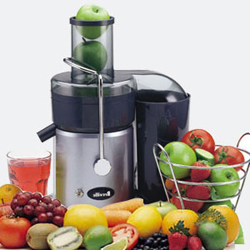 The juice of fresh fruits and vegetables is the richest available food source of vitamins, minerals, and enzymes. There is a miracle of energy supplied by live plants that comes from nothing else on our planet. Parrots are biologically adapted to assimilate their vitamins, minerals, and enzymes from live plants. The juice of these plants is the equivalent of a vitamin/mineral/enzyme cocktail that parrots consider a treat! Juicing for Parrots
The juice of fresh fruits and vegetables is the richest available food source of vitamins, minerals, and enzymes. There is a miracle of energy supplied by live plants that comes from nothing else on our planet. Parrots are biologically adapted to assimilate their vitamins, minerals, and enzymes from live plants. The juice of these plants is the equivalent of a vitamin/mineral/enzyme cocktail that parrots consider a treat! Juicing for Parrots
Because juicing removes the fiber, the important nutrients and phytochemicals found in plants are easily absorbed with little effort on the part of the digestive system. Fruit and vegetable juices provide a convenient source of enzymes. Enzymes are extremely important to health because they spark the essential chemical reactions that are necessary to life. Enzymes are required for digesting food, for stimulating the brain, for providing cellular energy, and for repairing all tissue.
Americans, it seems, really enjoy their juice. In fact, juice bars are becoming so popular that Entrepreneur magazine recently ranked them among the hottest business trends of the coming year. Enjoying juice at home with the help of a juicing machine can be a fun and easy way to get a concentrate of many of the vitamins, minerals and other nutrients that we and our parrots need in our daily diet. Fresh juice provides these nutrients in a tasty liquid from a live food rather than from a laboratory-created pill.
Dr. Dave McCluggage, a highly respected holistic veterinarian of Colorado, juices different combinations of health-giving fruits and vegetables for his parrot family, as well as for his human family. He recommends selecting a parrot's favorite fruit or vegetable for juicing. He says that apples are always a good choice for juicing, and he also recommends carrots, kale, spinach and other healthful fruits and vegetables. Dr. McCluggage said that although fiber is an important component of a parrot's diet, juice concentrates many nutrients in a tasty liquid that parrots easily can consume by drinking. He suggested offering the remaining pulp or fibrous leftovers from the juicing process in a separate dish or baked into birdie bread. Any remaining pulp can be used as an excellent composting material.
Fruits are the edible structure of flowering plants, or more specifically, the mature ovary of the plant. Nutritionally, they are loaded with vitamins, minerals, and enzymes. Some fruits contain protein and fats as well. Citrus fruits and berries also are rich in bioflavonoids. Vegetables are herbaceous plants that can be eaten whole or in part. This can include the tubers, roots, leaves, seeds, and flowering parts of the plant. They are composed primarily of water, and they are rich sources of many essential vitamins and minerals.
Parrots enjoy the many tastes, textures, and colors of whole fruits and vegetables. Juices of whole live foods should not be used as a substitute for fresh foods but rather as a supplemental source of vitamins and minerals. Most parrots cannot eat enough raw foods daily to get optimal levels of valuable nutrients, partially because our foods are grown in poor soils that have been stripped of their vitality by overuse. Add to this the problem of long-term storage of produce before it reaches the market place, and the nutrient content can be significantly lessened.
When using commercially prepared vitamin and mineral supplements, we easily can overdose parrots and negatively impact their sensitively balanced systems. The adverse effects can manifest themselves in a number of ways including overstimulation, nervousness, aggression, feather plucking, and even organ damage. By offering a highly concentrated but natural source of vitamins, minerals, and enzymes, we can circumvent the problem of overdosing parrots with laboratory-created nutrients.
The most significant difference between whole produce and the juice of fresh fruits and vegetables is that juicing eliminates the fiber--the indigestible part. Juicing makes the food easier to digest and assimilate. There are some ready-prepared juices available, but when you make your own, you know exactly what it contains. There will be no danger of added sugar or artificial sweeteners, preservatives, or other additives. Most commercially prepared juices are heat-treated to extend shelf life, which destroys valuable nutrients in the process. In addition to ensuring maximum nutrition, juicing allows you to be creative. You can make all kinds of taste-tempting combinations for your birds.
It is easy to make fresh healthful juices for your parrots and for yourself. You need only high-quality produce and a good juicer. There are many types of juicers available. I have an Acme brand juicer that is just as good today as when I bought it twenty years ago. A good juicer is an investment and not necessarily inexpensive. If you search the internet, you will find a wealth of information on all types of juicers which you can match to your particular needs. If you would like to try juicing before you invest in a juicer, use a small amount of water in a blender and pulverize and strain the fruits and vegetables.
If possible, buy organic produce--fruits and vegetables that have been grown without the use of pesticides or other harmful chemicals. Otherwise, avoid the most contaminated produce. See a safe and unsafe list here: Parrots, Produce and Pesticides. Conventionally grown tropical fruits should be peeled to remove the pesticide sprays which still are legal for use in many of the countries where they are grown.
Buy only the amount of produce that you will use in a few days' time, preferably no more than a week's worth, to prevent spoilage. Thoroughly wash your produce before juicing. Use a vegetable brush to remove any residue and waxes. You may also want to use a vegetable wash or a Citricidal product such as Nutribiotic or Agrisept which can be found in most health food stores. After thoroughly washing the produce, remove the skins of apricots, grapefruits, oranges, papaya, peaches, and pineapples. As a rule, leave small seeds in the fruits except for apple seeds. Remove all pits of apples before juicing in order to avoid the small amount of cyanide in them. You can leave most stems and leaves intact when juicing. However, rhubarb greens must be removed because they contain toxic substances. Cut the produce into pieces small enough for the feeding hatch on your juicer. To make leafy green vegetable juices such as kale, rapini, collard, spinach, mustard, and turnip greens more palatable, mix them with flavorful juices such as carrot or apple. All juices can be flavored with liquid concentrates of cherry or cranberry juices from health food stores. They should be added sparingly after juicing.
To serve fresh fruit and vegetable juices to your birds, it can be offered by hand in a small cup if you have only a few birds. If you have a flock of parrots, making individual hand servings impractical, it can be served by soaking dry foods in the juice. Bird bread, pellets, dry cereals such as shredded wheat squares, and other dry foods can be soaked in the fresh juice and given to parrots. Small amounts of fresh juice from organic produce are a healthful addition to baby parrot formula. Ideally, fresh juice should be consumed immediately after juicing, but leftovers can be stored briefly in the refrigerator in a glass container with an airtight lid or frozen in ice cube trays for later use. Some of the nutrients are lost in freezing, but it still is a tasty and healthful food.
As you experiment with juicing, you will discover the combinations of fruits and vegetables that please the palate of your birds and yourself. A good first juice might be a combination of four or five carrots, one half apple (without seeds), and a quarter-inch slice of ginger. The mainstay produce of juicing are carrots, apples, green foods, and beets. When juicing greens, garlic, broccoli, and other hard to handle foods, push them through the hopper of the juicer with carrots. Small pieces of dense produce such as garlic can be wrapped in the leafy greens such as kale for easier handling.
You haven't really tasted apple juice until you taste it fresh from your juicer. Since it contains a lot of natural sugar, it usually is combined with vegetables such as carrots, celery, spinach and others. This is a close tie with carrot juice as the favorite of parrots. All sweet fruits should be used sparingly as flavoring for other healthful juices. Juices contain simple sugars that we need for energy; however, because they are combined with other healthful nutrients, they are not harmful, as are refined sugars. Parrots that are prone to obesity, such as amazons, should not be allowed unlimited juice. As healthful as it is, it is not a low calorie food.
Perhaps it is due to the bright orange color and the fresh sweet taste, but for whatever reason, parrots love carrot juice. Fresh carrots are a tasty food containing many important nutrients. The body converts beta carotene into Vitamin A, which is important in strengthening the immune system and promoting healthy cell growth. Not only is it a precursor of vitamin A, it is a powerful antioxidant which neutralizes toxins in the system. A hefty ninety percent of the beta carotene of carrots is absorbed when carrots are juiced. Carrots also contain the recently discovered alpha carotene which is thought to be a powerful inhibitor of tumor growth. One carrot, seven inches long and one inch in diameter, yields the following nutrients: 27 mg. Calcium, 26 mg. Phosphorus, 0.5 mg. iron, 34 mg. Sodium, 246 mg. potassium , 7,930 I.U. vitamin A, trace amounts of B-complex vitamins, 6 mg. vitamin C, magnesium and chromium.
The American Journal of Clinical Nutrition reported in their October 1985 issue that "Carrot juice pulls heavy metals from tissues, binds them and discharges them from the body's system." Parrots are subject to heavy metal toxicity from a variety of sources, from the cookware that we use for food preparation, the water they drink, the air they breathe, and especially the pesticide-sprayed leafy greens that they eat, so the use of carrot juice as a chelating agent could be very important to their health.
There is a wonderful side benefit to juicing for your parrots. It is no more trouble to make enough juice for yourself and your family than to make a small portion for your birds. Unless you are eating three fourths of your diet raw, your own health will improve dramatically with the daily consumption of raw fruit and vegetable juices.
Parrots that regularly consume fresh fruit and vegetable juices have an unmistakable sheen to their feathers and shine in their eyes that let you know you are doing something right!
Here are some other foods that can be juiced to benefit specific conditions that affect parrots: (Always use spinach and parsley sparingly for parrots.)
Arthritis
- broccoli and kale--sources of pantothenic acid
- kale, parsley and spinach--sources of vitamin C
- spinach and carrot--sources of vitamin E
- carrot, ginger root, apple--sources of copper
- cherry and blueberry--sources of bioflavonoids
- pineapple--the only source of bromelain
Calcium Deficiency
- kale, mustard greens, carrots, kohlrabi, watercress, cabbage, turnip and beet tops
Candidiasis
- kale, spinach and turnip greens--sources of vitamin B-6
- red Swiss chard, turnip, garlic, and radish--sources of selenium
- parsley, beet greens, dandelion greens, and broccoli--sources of organic iron
Cancer Protection
beet juice--contains the sulphur amino acids and the sulphur-sugar complex known as betanin
Cataracts
- carrot, kale, parsley and spinach--sources of beta-carotene
- garlic--a juiceable source of vitamin B1
- spinach, currant, asparagus, broccoli, Brussel sprouts--sources of vitamin B2
- kale, parsley, green pepper and broccoli--sources of vitamin C
- spinach asparagus and carrot--sources of vitamin E
- red Swiss chard, turnip, garlic, and orange--sources of selenium
- carrot, garlic, and ginger root--sources of copper
- spinach, turnip greens, beet greens, and carrot--sources of manganese
- ginger root, parsley, garlic and carrot--sources of zinc
Feather, Skin and Nail Health
- parsnips--to improve taste, prepare with apple or carrot juice.
Fungal Infections
- garlic--rich in sulfur and potassium, kills fungus, bacteria, and intestinal parasites, and should be used sparingly for parrots. Juice with carrots and ginger for improved flavor.
Gout
- kale, beet greens, and broccoli--sources of folic acid
- kale, parsley, sweet pepper, and strawberry--sources of vitamin C
- pineapple--the only source of bromelain
- green vegetables--sources of omega-3 fatty acids
- cherry and strawberry--help to neutralize uric acid (remove cherry pits before juicing)
Infections
- blueberry and black currant--contain antibacterial agents
- grape, apple, and cabbage--contain antiviral and antibacterial compounds
- garlic--the most potent natural antibiotic
- pineapple--fresh juice contains enzyme bromelain, anti-inflammatory agent
- celery, carrot, and Swiss chard--contain high amounts of potassium and sodium
- ginger, parsley, and carrot--sources of zinc
- kale, red pepper, and collard greens--low-sugar* sources of vitamin C
- tomato, cabbage, and sweet pepper--low-sugar*sources of bioflavonoids
- carrot, kale, and spinach--low-sugar* sources of beta-carotene
- (Note: It is important not to use high-sugar foods when parrots have any type of infections.)
Liver Toxicity
- dandelion greens--best diluted with carrot juice.
- tomato--season juice with lemon juice or cayenne pepper, a favorite of parrots.
- carrot--juice is excellent liver cleanser
Metal Toxicity
- potato juice--According to Science Magazine, November 8, 1985, potatoes are an excellent source of simple peptides called "phytochelatins", useful in the removal of toxic heavy metals from the system.
- carrot juice, green peas, cabbage, tomato, cranberries. According to The American Journal of Clinical
- Nutrition, October 1985, these and other unspecified "fresh fruits" can pull heavy metals from fatty tissues where they reside, bind them and discharge them from the system.
Motion Sickness
- ginger--studies at Brigham Young University found ginger to be more effective than Dramamine.
- kale and spinach--sources of vitamin B-6
- sweet pepper, kale strawberry--sources of vitamin C
- turnip greens, broccoli, and lettuce--sources of vitamin K
Pain Relief
- chili peppers--Another favorite of parrots, the capsicum of hot peppers is now commercially prepared as a topical pain reliever, available in health food stores as a roll-on preparation and in capsule form. Dilute the juice of hot peppers in carrot juice to aid in pain relief of parrots following injury or surgery.
Sinus Problems
- kohlrabi--(member of the cabbage family) Add pineapple juice for flavor and improved assimilation.
Skin Disorders
- celery--source of calcium, phosphorus, potassium, vitamin A and B complex vitamins
- cucumber--source of calcium, phosphorus, potassium, vitamins A,B,C, magnesium, boron and chlorine
- beets--good source of sulphurs needed for healthy skin but should be used sparingly for parrots
- red grapes--seeds may be juiced too
Stress
- broccoli and kale--sources of pantothenic acid
- red pepper, kale, and collard greens--sources of vitamin C
- ginger, parsley, and carrot--sources of zinc
- collard greens and parsley--excellent sources of magnesium
- parsley, Swiss chard and spinach--sources of potassium
- carrot, collard greens and parsley--excellent sources of beta-carotene
Thyroid
- radishes and leafy tops--Raphanin (sulfur component) balances production of thyroxin.
Tonic
- wheat grass and barley grass--powerful chlorophyll-rich foods to be given parrots in very small doses
- cayenne--the most powerful and prolonged natural stimulant known.
Vision
- carrot juice--This richest source of vitamin A and carotenoids strengthens eyes and preserves vision.
- passion fruit--Peel and scoop out seeds before juicing.
*************
Carolyn Swicegood has written many excellent articles on the topics of avian diet, nutrition and health many of which can be found on her highly recommended website www.landofvos.com
Write comment (0 Comments)- Written by: Deb White
- Category: Diet & Nutrition
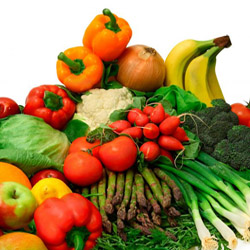 Nutrients are substances needed for growth, metabolism, and for other body functions. Macronutrients are nutrients that provide calories or energy. There are three macronutrients:
Nutrients are substances needed for growth, metabolism, and for other body functions. Macronutrients are nutrients that provide calories or energy. There are three macronutrients:
- carbohydrates
- protein
- fat
Micronutrients are nutrients that our bodies need in smaller amounts, and include vitamins and minerals. Micronutrients are essential to good health and the proper functioning of the body's systems.
The following table provides an overview of the micronutrients essential to your bird's health as well as information on their specific sources and benefits:
| Nutrient | Benefit & Source |
| Vitamin A | Prevention of bacterial infection, tissue and bone growth, healthy skin, vision, reproduction |
| carrots, yams, winter squash, broccoli, dark leaf greens, spinach, Swiss chard, corn, asparagus, green peppers, alfalfa, pumpkin, sweet potato, chili peppers, kale, soy beans, apricots, cantaloupe, papayas, mangos, nectarines, peaches, apples, blueberries, cranberries, guava, kiwi, plums, figs, dark grapes, bananas, pineapple, pomegranates | |
| Vitamin C | Needed during times of stress and illness, collagen and cortisone production |
| citrus fruits, spinach, broccoli, brussels sprouts, potatoes, beets, cantaloupe | |
| Vitamin D3 | Needed for the metabolism of calcium, enhances immunity, maintains healthy heart and nervous system |
|
Naturally synthesized with exposure to unfiltered UV radiation from direct sunlight (i.e., no glass) or from full spectrum lighting. hard boiled egg yolk, fish-liver oil, supplements |
|
| Vitamin E | Antioxidant, supports brain function, oxygen conservation, promotes healing |
| peanuts, almonds, safflower, walnuts, whole grain cereal, eggs, leafy greens and wheat germ | |
| Vitamin H | Metabolism of fats and carbohydrates, enzyme production |
| tuna, cooked egg yolks, soybeans, split peas, garbanzo beans, cauliflower, sunflower, peanuts, pecans, sesame seeds, wheat germ, oatmeal, chicken, cheese and banana | |
| Vitamin K | Regulates blood clotting, bone formation and repair |
| broccoli, Brussels sprouts, spinach, turnip greens, soybeans, alfalfa, oats, cheddar cheese | |
| Vitamin B1 | Vital to cellular reactions and normal functioning of the heart, muscles and nervous system |
| alfafa, soybeans, beets and dark leafy greens | |
| Vitamin B2 | Converts food to energy, healthy egg production, blood cell development, eyesight and skin health |
| cheese, bee pollen, wheat germ, beef, almonds, chicken | |
| Vitamin B3 | Energy for cells, healthy feathers |
| halibut, tuna, turkey, dried peaches, barley, peanuts, sunflower, almonds, brewer's yeast | |
| Vitamin B5 | Fatty acid breakdown and carbohydrate metabolism, relieves stress |
| blue cheese, eggs, turkey, corn, peas, soybeans, walnuts, lentils, wheat germ, brewer's yeast | |
| Vitamin B6 | Synthesis of oxygen in blood, amino acid breakdown, brain and nervous system |
| wheat germ, hazelnuts, sunflower, soybeans, tuna | |
| Vitamin B12 | Cell division and growth, red blood cell development, metabolism of fats, proteins and carbohydrates |
| shellfish, swiss cheese, blue cheese, beef, ocean fish | |
| Folic Acid | Production of red blood cells |
| sprouts, wheat germ, endive, asparagus, collard greens, barley, almonds, cashews | |
| Calcium | Building and maintenance of strong bones, eggshell development, blood clotting, nerve transmission, metabolism of vitamin D |
| egg shell, yogurt, Swiss chard, Swiss cheese, low fat cheese, beet greens, kale, collard greens, mustard greens, turnip greens, sesame seeds, watercress, cuttlebone, mineral block, oyster shell, alfalfa meal, whey, broccoli leaves, spinach, cabbage (outside leaves) | |
| Phosphorous | Metabolism of fats, formation of bones, metabolism of carbohydrates, proteins and fats, acid balance, nerve and heart health, kidney function |
| cereal grains, hard boiled egg, pumpkin seeds, peanuts, fish and meat, brewer's yeast, dried whey, wheat germ meal, yogurt, chicken and garlic | |
| Magnesium | Regulates acid-base balance, facilitates absorption and metabolism of calcium and phosphorous |
| whole grains, dark leafy greens, almonds, corn, apples |
- Category: Diet & Nutrition
 Not so long ago, seed mixes were the only commercially available diet option for pet birds. We now know that providing a seed only diet results in malnourishment and dramatically shortened life spans for our birds.
Not so long ago, seed mixes were the only commercially available diet option for pet birds. We now know that providing a seed only diet results in malnourishment and dramatically shortened life spans for our birds.
Many captive parrots suffer from malnutrition in captivity because they exist solely on commercial seed diets.
The good news is that today we have a wide variety of healthy and interesting choices available to us commercially including:
- Formulated diets (pellets and extruded diets)
- Soak & Cook diets
- Dehydrated fruits
- Dehydrated veggies
- Birdie Breads
- Treats
- Seed Mixes
The vast majority of avian experts recommend a formulated diet over a seed diet. Pelleted & extruded diets have been formulated to include a balanced selection of vitamins, minerals, carbohydrates and proteins all compacted into one easy form.
The primary advantages of formulated diets are:
- Consistent and balanced nutritional content in every bite.
- Less mess to clean up (no seed hulls)
- No need to add supplements such as vitamins and minerals.
- Less waste
The major downfall of a pellet-only diet is that it is B-O-R-I-N-G.
Seed diets are relatively inexpensive and easy to obtain at the local grocery. However, many bird owners have unfortunately made seed the only choice for their birds diet. The major problem with seed diets is the relatively high fat content of the components typically contained within those mixes. Sunflower seeds, safflower seeds and peanuts all have fat content levels approaching 50%. Since domestic birds get a fraction of exercise that their wild counterparts do, they can not burn off the fat. A high fat diet leads to obesity as well as other health problems such as; heart disease, fatty liver disease, fatty tumors and skin and feather problems. Seed diets also lack many of the necessary nutrients (vitamins and minerals) required by your bird.
Within the seed category, there are certainly healthier choices that can be made such as supplemented mixes and mixes with lower fat content seeds. Supplemented seed mixes are those that contain some fortification via the addition of pellets or sprayed on, baked on or powdered vitamins, minerals or amino acids.
Even though popular consensus is that pellets are nutritionally advantageous over seed diets, this doesn't mean that seeds should be entirely eliminated from your bird's diet. When used as a component of your bird's overall nutritional plan, seed can be beneficial and add to your birds enjoyment. Birds enjoy cracking open seeds and foraging through the mix, searching for their favorites. We recommend that seeds be used as only a minor (i.e., <10%) component of your bird's diet. If you do choose to supplement your bird's diet with a sprinkling of seeds, be sure to choose a healthy seed mix.
Write comment (0 Comments)- Category: Diet & Nutrition
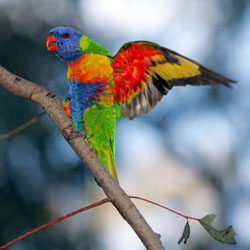 It's just plain common sense to realize that species native to drastically different ecological and environmental climates, each with vastly different food sources available, would have evolved with different nutritional needs.
It's just plain common sense to realize that species native to drastically different ecological and environmental climates, each with vastly different food sources available, would have evolved with different nutritional needs.
Over the past few several years, it has been acknowledged that nutritional needs do vary by individual parrot species and, as a result, some manufacturers have developed species specific formulated diets. For example, low fat content for Amazons, higher fat content for Macaws, increased vitamin A for Eclectus and low iron diets for softbills.
There are ongoing studies to understand the requirements of various species but honestly, the science has a long way to go. Most of our knowledge of avian nutritional requirements has been developed from studies conducted on poultry....yes, chickens.
The basic nutrients needed are the same for all avian species, however, the source of the nutrients and levels required vary between species and even within a species depending on the status of the individual bird (i.e., age, activity level, breeding status, sex, health, size, environmental conditions, etc.)
Bird owners are encouraged to consult with their avian vet as well as to research the crops, fruits, nuts and other flora indigenous to the geographical area native to their species of bird. Armed with this knowledge, it is then possible to incorporate the most appropriate foods and supplements into their birds overall feeding plan.
Again, we would like to emphasize, that no one commercial diet comes close to simulating how our birds eat in nature and none of the commercial diets provide for 100% of the nutritional needs of our birds. We must arm ourselves with as much knowledge as possible about our birds, their native environment and to do the best we can to meet their needs by providing a well rounded selection of healthy foods.
Write comment (0 Comments)